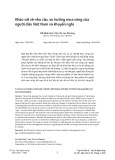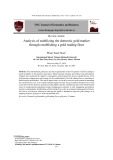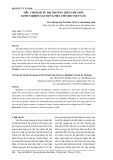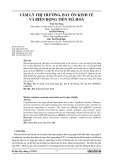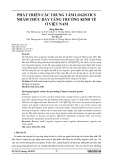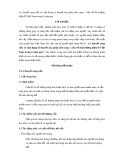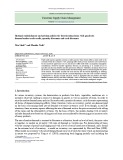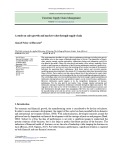
Chapter 18
The Markets For the Factors of Production
TRUE/FALSE
1. If the marginal productivity of the sixth worker hired is less than the marginal productivity of the fifth worker
hired, then the addition of the sixth worker causes total output to decline.
ANS: F DIF: 2 REF: 18-1
NAT: Analytic LOC: Labor markets TOP: Marginal product of labor
MSC: Interpretive
2. In 2008, the total income of all U.S. residents was approximately $120 billion.
ANS: F DIF: 1 REF: 18-0
NAT: Analytic LOC: Labor markets TOP: Income
MSC: Interpretive
3. In order to calculate the value of the marginal product of labor, a manager must know the marginal product of
labor and the wage rate of the worker.
ANS: F DIF: 2 REF: 18-1
NAT: Analytic LOC: Labor markets
TOP: Value of the marginal product MSC: Interpretive
4. Let L represent the quantity of labor and let Q represent the quantity of output. Suppose a certain production
function includes the points (L = 7, Q = 27), (L = 8, Q = 35), and
(L = 9, Q = 45). Based on these three points, this production function exhibits diminishing marginal product.
ANS: F DIF: 2 REF: 18-1
NAT: Analytic LOC: The study of economics, and definitions of economics
TOP: Diminishing marginal product MSC: Applicative
5. When a competitive firm hires labor up to the point at which the value of the marginal product of labor equals
the wage, it also produces up to the point at which the price of output equals average variable cost.
ANS: F DIF: 3 REF: 18-1
NAT: Analytic LOC: The study of economics, and definitions of economics
TOP: Competitive firms | Profit maximization MSC: Applicative
6. The demand for computer programmers is inseparably tied to the supply of computer software.
ANS: T DIF: 1 REF: 18-1
NAT: Analytic LOC: Labor markets TOP: Labor demand
MSC: Interpretive
7. If Firm X is a competitive firm in the market for labor, it has little influence over the wage it pays its
employees.
ANS: T DIF: 1 REF: 18-1
NAT: Analytic LOC: Labor markets TOP: Labor demand
MSC: Interpretive
8. The idea that rational employers think at the margin is central to understanding how many units of labor they
choose to employ.
ANS: T DIF: 1 REF: 18-1
NAT: Analytic LOC: Labor markets TOP: Labor demand
MSC: Interpretive
9. For competitive firms, the curve that represents the value of marginal product of labor is the same as the
demand for labor curve.
ANS: T DIF: 2 REF: 18-1
NAT: Analytic LOC: Labor markets
TOP: Labor demand | Value of the marginal product MSC: Interpretive
195

196 Chapter 18/The Markets For the Factors of Production
10. The value of the marginal product of labor can be calculated as the price of the final good minus the marginal
product of labor.
ANS: F DIF: 2 REF: 18-1
NAT: Analytic LOC: Labor markets
TOP: Value of the marginal product MSC: Analytical
11. To compute the value of the marginal product of capital, you should multiply the market price of the good by
the marginal product of capital.
ANS: T DIF: 2 REF: 18-1
NAT: Analytic LOC: Labor markets
TOP: Value of the marginal product MSC: Analytical
12. A profit-maximizing competitive firm will hire workers up to the point at which the wage equals the price of
the final good.
ANS: F DIF: 2 REF: 18-1
NAT: Analytic LOC: Labor markets
TOP: Labor demand | Value of the marginal product MSC: Analytical
13. A profit-maximizing competitive firm will hire workers up to the point at which the wage equals the marginal
product of labor.
ANS: F DIF: 2 REF: 18-1
NAT: Analytic LOC: Labor markets
TOP: Labor demand | Marginal product of labor MSC: Analytical
14. Technological advances can cause the labor demand curve to shift.
ANS: T DIF: 2 REF: 18-1
NAT: Analytic LOC: Labor markets TOP: Labor demand
MSC: Applicative
15. In the United States, technological advances help explain persistently rising employment in the face of rising
wages.
ANS: T DIF: 2 REF: 18-1
NAT: Analytic LOC: Labor markets TOP: Labor demand
MSC: Applicative
16. The term Luddite refers to “tekkies” or people who are the first to adopt new technological advances.
ANS: F DIF: 1 REF: 18-1
NAT: Analytic LOC: Labor markets TOP: Labor demand
MSC: Definitional
17. Labor-saving technological advances increase the marginal productivity of labor.
ANS: F DIF: 1 REF: 18-1
NAT: Analytic LOC: Labor markets TOP: Labor demand
MSC: Definitional
18. Labor-saving technological advances decrease the marginal productivity of labor.
ANS: T DIF: 1 REF: 18-1
NAT: Analytic LOC: Labor markets TOP: Labor demand
MSC: Definitional
19. Labor-augmenting technological advances increase the marginal productivity of labor.
ANS: T DIF: 1 REF: 18-1
NAT: Analytic LOC: Labor markets TOP: Labor demand
MSC: Definitional
20. Labor-augmenting technological advances decrease the marginal productivity of labor.
ANS: F DIF: 1 REF: 18-1
NAT: Analytic LOC: Labor markets TOP: Labor demand
MSC: Definitional

Chapter 18/The Markets For the Factors of Production 197
21. An increase in a product’s price will shift the labor demand curve for that product to the left.
ANS: F DIF: 1 REF: 18-1
NAT: Analytic LOC: Labor markets TOP: Labor demand
MSC: Definitional
22. The quantity available of one factor of production can affect the marginal product of other factors.
ANS: T DIF: 2 REF: 18-1
NAT: Analytic LOC: Labor markets
TOP: Marginal product of labor | Factor markets MSC: Applicative
23. In a competitive market for labor, the equilibrium wage always equals the value of the marginal product.
ANS: T DIF: 2 REF: 18-1
NAT: Analytic LOC: Labor markets
TOP: Value of the marginal product MSC: Applicative
24. From 1960 to 2000, inflation-adjusted wages increased by 131 percent in the U.S. As a result, firms reduced
the amount of labor they employed by nearly 20 percent.
ANS: F DIF: 2 REF: 18-1
NAT: Analytic LOC: Labor markets TOP: Labor demand
MSC: Interpretive
25. The labor-supply curve is affected by the trade-off between labor and leisure.
ANS: T DIF: 2 REF: 18-2
NAT: Analytic LOC: Labor markets TOP: Labor supply
MSC: Interpretive
26. The opportunity cost of leisure is impossible to measure, since we can't measure leisure time in dollars.
ANS: F DIF: 2 REF: 18-2
NAT: Analytic LOC: Labor markets TOP: Labor supply
MSC: Interpretive
27. The labor supply curve reflects how workers' decisions about the labor-leisure tradeoff respond to changes in
the opportunity cost of leisure.
ANS: T DIF: 2 REF: 18-2
NAT: Analytic LOC: Labor markets TOP: Labor supply
MSC: Interpretive
28. Labor supply curves are always upward sloping.
ANS: F DIF: 2 REF: 18-2
NAT: Analytic LOC: Labor markets TOP: Labor supply
MSC: Interpretive
29. When an individual’s income goes up, that individual may choose to supply less labor, resulting in a
backward-sloping labor supply curve.
ANS: T DIF: 2 REF: 18-2
NAT: Analytic LOC: Labor markets TOP: Labor supply
MSC: Interpretive
30. The supply of labor in any one market depends on the opportunities available in other markets.
ANS: T DIF: 2 REF: 18-2
NAT: Analytic LOC: Labor markets TOP: Labor supply
MSC: Applicative
31. Movements of workers from country to country can cause shifts in the labor supply curves for both countries.
ANS: T DIF: 2 REF: 18-2
NAT: Analytic LOC: Labor markets TOP: Labor supply
MSC: Applicative

198 Chapter 18/The Markets For the Factors of Production
32. If the demand for labor in a particular industry increases, the equilibrium wage in that industry will also
increase.
ANS: T DIF: 2 REF: 18-3
NAT: Analytic LOC: Labor markets TOP: Labor-market equilibrium
MSC: Analytical
33. If the demand for labor decreases and the supply of labor is unchanged, then the opportunity cost of leisure
will decrease.
ANS: T DIF: 2 REF: 18-3
NAT: Analytic LOC: Understanding and applying economic models
TOP: Opportunity cost | Wages MSC: Interpretive
34. Profit maximization by firms ensures that the equilibrium wage always equals the value of the marginal
product of capital.
ANS: F DIF: 2 REF: 18-3
NAT: Analytic LOC: Understanding and applying economic models
TOP: Marginal product | Wages MSC: Interpretive
35. As the number of concrete workers in the United States falls, the wage paid to the remaining concrete workers
will necessarily fall as well.
ANS: F DIF: 2 REF: 18-3
NAT: Analytic LOC: Labor markets TOP: Labor-market equilibrium
MSC: Applicative
36. Oil field workers' wages are directly tied to the world price of oil.
ANS: T DIF: 1 REF: 18-3
NAT: Analytic LOC: Labor markets TOP: Labor-market equilibrium
MSC: Applicative
37. Changes in supply and demand in the labor market will cause changes in wages.
ANS: T DIF: 1 REF: 18-3
NAT: Analytic LOC: Labor markets TOP: Labor-market equilibrium
MSC: Definitional
38. In general, less productive workers are paid less than more productive workers.
ANS: T DIF: 1 REF: 18-3
NAT: Analytic LOC: Labor markets TOP: Labor-market equilibrium
MSC: Applicative
39. Increases in productivity are not responsible for increased standards of living in the United States.
ANS: F DIF: 2 REF: 18-3
NAT: Analytic LOC: Labor markets TOP: Factor markets
MSC: Applicative
40. Average productivity can be measured as total output divided by total units of labor.
ANS: T DIF: 1 REF: 18-3
NAT: Analytic LOC: Labor markets TOP: Factor markets
MSC: Definitional
41. The rental price of capital is the price a person pays to own the capital indefinitely.
ANS: F DIF: 2 REF: 18-4
NAT: Analytic LOC: Understanding and applying economic models
TOP: Capital market MSC: Interpretive
42. The marginal product of land depends on the quantity of land that is available.
ANS: T DIF: 2 REF: 18-4
NAT: Analytic LOC: Labor markets TOP: Land markets
MSC: Interpretive

Chapter 18/The Markets For the Factors of Production 199
43. For a snow-removal business, the capital stock would include inputs such as snow blowers and shovels.
ANS: T DIF: 1 REF: 18-4
NAT: Analytic LOC: Labor markets TOP: Capital
MSC: Definitional
44. The demand curve for each factor of production equals the value of the marginal product of that factor.
ANS: T DIF: 2 REF: 18-4
NAT: Analytic LOC: Labor markets TOP: Factor markets
MSC: Interpretive
45. Capital income does not include income paid to households for the use of their capital.
ANS: F DIF: 2 REF: 18-4
NAT: Analytic LOC: Labor markets TOP: Capital income
MSC: Definitional
46. Firms pay out a portion of their earnings in the form of interest and dividends, and those payments are a
portion of the economy's capital income.
ANS: T DIF: 2 REF: 18-4
NAT: Analytic LOC: Labor markets TOP: Capital income
MSC: Definitional
47. When a firm decides to retain its earnings instead of paying dividends, the stockholders necessarily suffer.
ANS: F DIF: 2 REF: 18-4
NAT: Analytic LOC: Labor markets TOP: Capital
MSC: Interpretive
48. Capital owners are compensated according to the value of the marginal product of that capital.
ANS: T DIF: 2 REF: 18-4
NAT: Analytic LOC: Labor markets TOP: Capital
MSC: Interpretive
49. A change in the supply of any one factor alters the earnings of all the other factors.
ANS: T DIF: 2 REF: 18-4
NAT: Analytic LOC: Labor markets TOP: Factor markets
MSC: Interpretive
50. If the output price of a product rises, the demand for capital will increase, raising the rental price of capital.
ANS: T DIF: 1 REF: 18-4
NAT: Analytic LOC: Labor markets TOP: Capital
MSC: Applicative
51. Suppose the supply of capital decreases. As a result, the quantity of capital used in production and the rental
price of capital will both fall.
ANS: F DIF: 2 REF: 18-4
NAT: Analytic LOC: Labor markets TOP: Capital
MSC: Analytical
52. Suppose an influenza pandemic were to significantly decrease the population of a country. We would predict
a decrease in the marginal product of land in that country.
ANS: T DIF: 2 REF: 18-4
NAT: Analytic LOC: Labor markets TOP: Land markets
MSC: Analytical

